JAPANESE-SOVIETS CLASH AT KHALKHYN GOL
Moscow, Soviet Union • August 20, 1939
The Soviet Union and Japan, 2 expansionist powers that occupied portions of the Asian mainland, had butted heads as early as 1904–1905 (the Russo-Japanese War) over influence in China, Mongolia, and Manchuria, the latter country rich in coal, iron, and grains. In September 1931 soldiers in the Kwantung Army, as Japan’s largest, most prestigious army on the Chinese mainland was called, used a ruse—the so-called Mukden Incident—to seize Manchuria, which bordered the Japanese colony of Korea on the east and, on the west, Mongolia, a de facto puppet state of the Soviet Union. The Kwantung Army named their Manchurian conquest Manchukuo and installed a puppet government there.
The Kwantung Army quickly embarked on a program of detaching provinces on Manchukuo’s border with China and turning them into buffer zones or client states. In July and August 1938 and again from May to August 1939, the Kwantung Army provoked 2 border wars, the Zhanggufeng (Chang-ku-feng) Incident and the Nomonhan (or Khalkhyn Gol) Incident, with the Soviet Union. Both conflicts were stage-managed by local commanders without the concurrence of the War Ministry in Tokyo. In the first “incident” insubordinate units in the Kwantung Army and the Japanese Army in Korea launched an attack across the Soviet border on July 29, 1938, and chased the Soviets off Zhanggufeng, a strategic hill in the area where the southeastern border of Manchukuo intersected with the boundaries of the Soviet Maritime Province and Korea. Soviet infantry troops numbering 23,000, with tanks and armored vehicles and supported by heavy artillery and air cover, retook the hill on August 9 at a steep price. Two days later the countries entered into a truce.
The reality of Japan’s defeat made no impression on local commanders, for next spring they launched several more unsanctioned military actions against Soviet forces in the vicinity of Nomonhan, a village on the border between Manchukuo and Mongolia (see map). On this date, August 20, 1939, days before the German invasion of Poland, the 2 adversaries began a massive 10‑day tank battle near the Mongolian Khalkha River that resulted in a spectacular Japanese defeat. It was the largest tank battle the world had yet seen and arguably the first decisive battle of the Second World War.
The Japanese defeat at Khalkhyn Gol had the most profound implications on the conduct of World War II. Since 1937 Japan had been engaged in a protracted, knockdown drag-out fight in China, which lay to the south and east of Manchukuo. The stunning Soviet victory, followed by a ceasefire on September 15, 1939, and then an agreement between the 2 belligerents to respect the borders of Mongolia and Manchukuo, persuaded expansionist circles in Tokyo (particularly the Imperial Japanese Navy) to look to Southeast Asia, where they saw the United States, the Netherlands, Britain, and France—all of whom had resource-rich but ill-defended possessions there—as weaker opponents than the Soviets on the Asian mainland.
Japan’s strategic change in course, prompted by its second battlefield loss to the Soviets in as many years, eventually led to a change in that country’s expansionist fortunes, beginning with its successful attacks on the Philippines, the Dutch East Indies (Indonesia), British Malaya (Malaysia), Singapore, and the American possession of Hawaii on December 7 and 8, 1941. Sadly for Japan, the change in course also presaged its tragic downfall.
Battles of Khalkhyn Gol: Japan versus the Soviet Union, May 11 to September 15, 1939
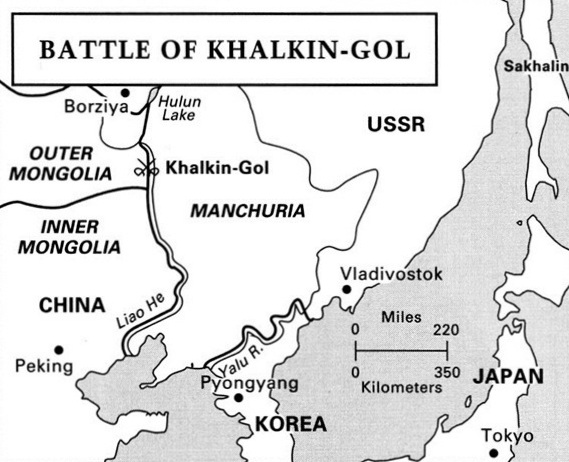
Above: Location of Khalkhyn Gol on the Asian mainland. The Kwantung Army’s takeover of Manchuria in 1931 brought Japanese and Soviet armed forces toe to toe along a 3,000‑mile/4,828‑kilometer border. Numerous border skirmishes and disputes punctuated the next several years as both sides reinforced their respective forces. In 1936 the Soviets signed a mutual assistance treaty with Mongolia (sometimes informally called Outer Mongolia), and in 1938 stationed forces in that country.
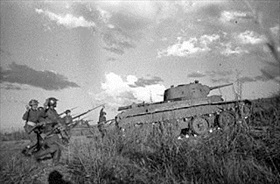 | 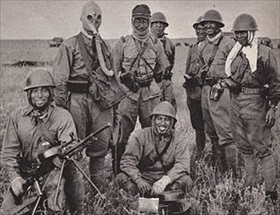 |
Left: A 3-man Soviet BT-7 light cavalry tank on the offensive, Khalkhyn Gol, August 1939. The 4‑month conflict was named after the Khalkha River (Khalkhyn Gol), which flows through the battlefield. In Japan the conflict is known as the Nomonhan Incident, named after a nearby village on the border between Mongolia and Japanese-occupied Manchuria (Manchukuo).
![]()
Right: Japanese soldiers pose with captured Soviet equipment during one of the Battles of Khalkhyn Gol. After Japan’s occupation of Korea (1905) and Manchuria (1931), its military leaders in China, essentially army commanders, focused expansionist aims on the Soviet Maritime Province adjacent to Korea’s northeast, Siberia, and Soviet Mongolia, and conflicts occurred frequently on the Manchurian border from mid-1929 onward. The army’s aggressive plans on the Asian mainland sometimes caught the civilian government in Tokyo by surprise, as the 1931 Mukden Incident (also known as the Manchurian Incident) and the 1938 Zhanggufeng (Chang-ku-feng) Incident showed.
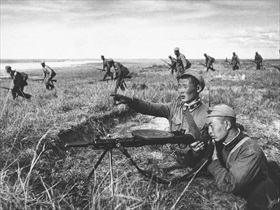 | 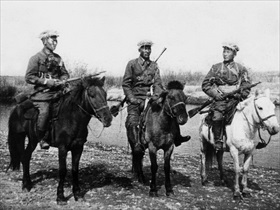 |
Left: Soldiers of the Mongolian People’s Army fight against Japanese soldiers, Khalkhyn Gol, 1939. The Mongolian People’s Republic was proclaimed in November 1924 after Soviet troops expelled White Russian and Chinese forces from Mongolia. Mongolia then became a de facto puppet state of the Soviet Union.
![]()
Right: Mongolian cavalry during the Battle of Khalkhyn Gol, 1939. After Soviet and Mongolian armed forces had defeated Japanese forces in the summer of 1939, the warring parties entered into a truce, set up a commission to define the Mongolian-Manchurian border later in the year, and entered into a neutrality pact that lasted until August 1945.
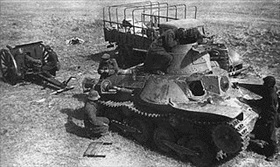 | 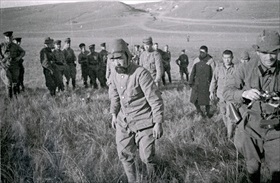 |
Left: A Japanese light tank (Type 95 Ha-Go) captured by Soviet troops after the Battle of Khalkhyn Gol. Six years later, on August 9, 1945, Soviet forces invaded Manchuria (Manchukuo). The rapid defeat of Japan’s Kwantung Army was a significant factor in Japan’s surrender to the Allies. Japanese leaders imagined the Red Army in Manchuria as poised to invade the Home Islands with boots on the ground, while the Americans were viewed as perfectly content to continue incinerating Japan from the air.
![]()
Right: Captured Japanese soldiers, Khalkhyn Gol, August 1939. Khalkhyn Gol resulted in a total defeat for the Japanese Sixth Army, a garrison force based in Manchukuo under the overall command of the Kwantung Army. The 23rd Division, the primary Japanese infantry division involved in the Battle of Khalkhyn Gol, suffered 11,958 men killed, or about 80 percent of its combat strength, including most of its regimental commanders.
Khalkhyn Gol: History’s Forgotten Battle
![]()

 History buffs, there is good news! The Daily Chronicles of World War II is now available as an ebook for $4.99 on Amazon.com. Containing a year’s worth of dated entries from this website, the ebook brings the story of this tumultuous era to life in a compelling, authoritative, and succinct manner. Featuring inventive navigation aids, the ebook enables readers to instantly move forward or backward by month and date to different dated entries. Simple and elegant! Click
History buffs, there is good news! The Daily Chronicles of World War II is now available as an ebook for $4.99 on Amazon.com. Containing a year’s worth of dated entries from this website, the ebook brings the story of this tumultuous era to life in a compelling, authoritative, and succinct manner. Featuring inventive navigation aids, the ebook enables readers to instantly move forward or backward by month and date to different dated entries. Simple and elegant! Click 











